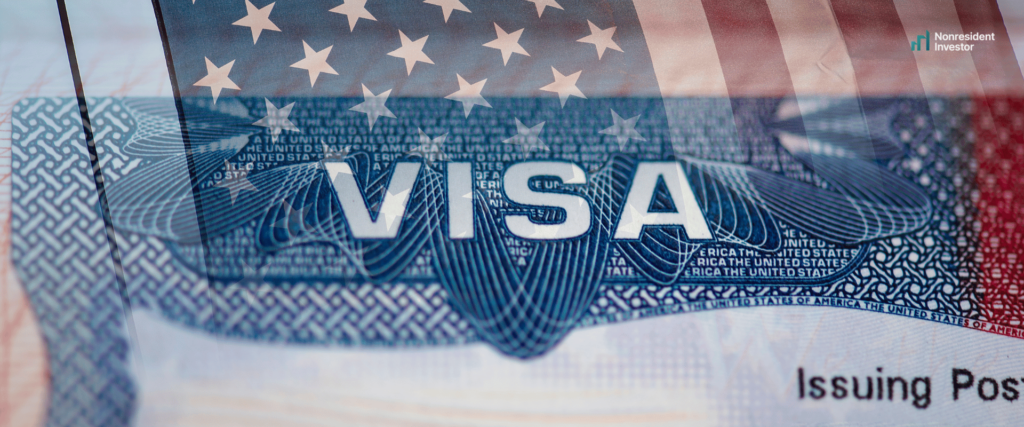Let’s get one thing straight — nothing can guarantee that you’ll get a US visa or US papers. Buying a property in the States doesn’t automatically make you eligible for a US Green Card. At the same time, having a visa or a Green Card isn’t a necessity for real estate investment. But yes, you can surely get a green card through real estate investment.
The US real estate market is entirely liberal. That means that anyone can invest in it, provided they have capital. Foreign investors are welcome and even encouraged to invest in the US real estate market, which is why they invested over $59 billion in 2022.
However, that doesn’t mean that the States are chock-full of Green Card holders who got their papers through investing.
Related: Can Foreigners Buy US Real Estate? Everything Nonresidents Should Know
Overall, buying US real estate doesn’t guarantee you’ll get American papers. Still, you can use some of the investment visas (and your investments) to obtain a residence and then a Green Card through real estate investment.
There are 3 different routes that aspiring nonresident investors can take:
- Tourist Visas,
- Treaty Trader Visas, and
- Golden Visas.
We’ll talk about all 3 options in detail and help you determine which one of them is the best choice for you and your future investments.

Types of Visas Available to Real Estate Investors
One of the first questions our clients ask is, “Do I need a US visa to buy real estate?”
The answer to that question is, of course, no. You don’t even need to go to the US in order to buy a property there — you can do everything online (although shopping for houses online does have its own set of pros and cons).
However, plenty of future and current real estate investors opt to get a visa anyway — whether to be able to go to the US to inspect the property and close a deal or as a way of getting temporary or (in some cases) permanent residence.
Visitor Visas
Visitor visas, more commonly known as tourist visas, are the main visa type that foreign investors opt for when they start their journey of investing in the US real estate market. However, the term “tourist” can be somewhat misleading, given that visitor visas are also available for business purposes.
All foreigners who want to enter the US need one of the following two:
- A temporary stay visa (that’s for nonimmigrants), or
- A permanent residence visa (that’s for immigrants).
Both types of visitor visas fall into the first category as they are temporary. They are also multiple-entry visas.
Depending on what the purpose of your visit is, you can opt for the:
- B1 visitor visa or business visa, or
- B2 visitor visa, or tourism visa.
There’s also a combination visa at your disposal — the B1/B2 visa.
All visitor visas are an excellent choice for nonresident investors because they are:
- Relatively easy to obtain,
- Stipulation-free (as in, there are no additional requirements you have to meet), and
- Affordable.
So, if you’re looking to get into the US, find a good real estate deal, close it, and then go home, either of the visitor visas will serve your purpose.
Still, let’s take a look at both of them and see what each of them has to offer.

Visa B1
The B1 visa is a business visa that you can apply for if you have business-related things to do in the US. So, for example, if you have to:
- Attend a conference,
- Consult with business contacts or associates,
- Attend a meeting or a convention,
- Negotiate a contract,
- Get a license, or
- Settle an estate,
then you’ll get a B1 visa to enter the States.
This visa is specifically tied to business-related activities, and it’s a multi-entry visa. That means that it allows you to enter the US multiple times for short visits. It’s not intended to be used for more permanent stays.
The B1 visa has a government filing fee of $185, which is why most nonresident investors opt for it. If you only need to get in and out of the States a couple of times in order to find a good deal, close it, and sort out the paperwork, then the B1 visa is a great choice.
Visa B2
The B2 visa or the Tourism Visa is a good choice for those who are looking to get into the States in order to have a vacation, do tourist things, participate in social events, or visit friends or family. It’s actually rare that you get assigned just a B1 or B2 visa since they are usually issued together.
That makes matters easier for nonresident investors since they don’t have to opt for just one. The B2 visa has the same government filing fee as the B1 visa.
The requirement you have to meet in order to qualify for the tourism visitor visa is that your reason for visiting needs to be one of the following:
- Socializing — if you have friends or family in the US, you can apply for a B2 visa in order to be granted access to the States to visit them.
- Tourism — whether you’re exploring and sightseeing in just one location, or multiple ones, you need to obtain a B2 visa.
- Medical treatment and/or medical tourism — if you require a medical procedure or a treatment that is available in the States, you’ll be granted a B2 visa that will allow you to enter the country and receive said treatment.
- Attending social events — if you’re attending a social event of any kind, such as a class, talk, concert, festival, gathering, or convention, you need to obtain a B2 visa for those purposes.
- Participation in events — as long as you’re not getting monetary compensation for your participation, you can still attend events as a participant on a B2 visa.

Treaty Visas
The second option people opt for is to go the treaty visas route. These visas are otherwise known as E1 and E2 visas or investor visas.
These are also nonimmigrant visas, just like the visitor visas, however, they are only available to citizens of countries that have a treaty of commerce and navigation contract with the United States.
Just like with the previous two, the treaty trader visas (and your real estate investment) don’t guarantee that you’ll ultimately get papers. However, they will provide you with a temporary residence that you can then, if you want, change by applying for another visa or for a Green Card.
The E1 and E2 visas aren’t the ideal choice for real estate investors because they require you to have an active business with at-risk capital. Real estate is, by nature, a passive business (which is one of its many benefits).
However, if you’re looking to start a real estate business that’s a bit more active — for example, a property management business, or a renovation business that involves you buying and flipping houses — and it involves a lot of capital turnover, then the E1 or E2 visas might be a good choice for you.
Let’s see what each of them entails.
Visa E1 — Treaty Trader Visa
Both the E1 and E2 visas are available to citizens of specific countries. The E1 visa is also known as a treaty trader visa and you obtain it when you want to trade your services, technology, activities, or goods internationally (meaning between the US and your home country).
The E1 visa is more often used by consultants, proprietors, IT companies, etc. There’s no limit on how big or small the trade in question has to be, which is a great benefit for investors.
However, do keep in mind that it’s important there are multiple trades (the more, the better) because the US government places an emphasis on the number of trades rather than the quantity of each individual trade.
Furthermore, the E1 visa also covers spouses and children of the applicant and grants the spouse the ability to work in the US and the children the option to study in the US.
The application fee is $205 but there are additional fees as well that depend on which country you’re coming from and which industry you’re working in. The US Citizenship And Immigration Services website offers a free calculator that will help you find out how much the E1 visa will actually cost you.

Visa E1 Requirements
In order to be eligible for an E1 visa and maintain that status once you obtain it, you have to meet specific requirements:
- You have to be a citizen of a country that has a treaty with the US. In the case of employment, the company you work for has to be at least 50% owned by citizens of a country that has a treaty with the US.
- No less than 50% of the trade you, the visa holder, or the company that employs you as a trader do has to be conducted between your country and the US.
- During your visa duration, you have to engage in “substantial” trading. Substantial trading isn’t precisely defined, as it depends on the type of trade and the industry you’re trading in. However, you do have to trade products, goods, or services in bulk and continuously.
- You can trade practically anything and in any industry, as the visa requirements don’t put a limit on that. However, no matter what you trade, you have to show proof that you’ll return to your home country after a designated period of trading.
If you meet all the requirements and you obtain an E1 visa, you’ll have the option of trading within the US for up to 2 years. After that, you can either prolong your E1 visa or apply for a Green Card.
Given that all dependants (your spouse and children) can not only come with you to the US but also work or study during your stay there, this visa is a good choice for investors who are looking to expand their business into the US while also searching for a way to give their family a life in the US.
Visa E2 — Treaty Investor Visa
The E2 visa is similar to the E1 visa, in that you need to be a citizen of a country that has a signed treaty with the US.
However, unlike the E1 visa, the E2 visa, also known as the investor visa, is a great option for entrepreneurs and investors (hence the name). If you’re a nonresident investor who’s looking to temporarily relocate to the US to do business, then the E2 visa might be for you.
This nonimmigrant, multi-entry visa allows you to:
- Start a US business,
- Work with other US businesses, and
- Invest in US businesses.
However, as mentioned before, the investment you make has to be at-risk. That means that there’s a real chance of both profits and losses that indicates your business is actually operational and active.
What’s more, the investment you make has to be in cash or rather not borrowed. You have to invest your actual money and, depending on the industry you’re investing in, you have to invest a specific amount (or higher). This amount can be as low as $250,000 for franchise businesses or as high as $1,000,000 for those operating within the IT sector. However, since the amount isn’t precisely specified but depends on the industry, you might be able to obtain the E2 visa with an investment as low as $50,000 or $100,000.

Visa E2 Requirements
To obtain an E2 visa, you need to meet specific requirements:
- You have to be a citizen of a country that has a signed treaty with the States.
- You can do business in the US only if you own the company you’ll be working for or if you’re a key employee in a company that’s at least 50% owned by citizens of your country.
- You have to make a substantial investment and put substantial capital or your assets at risk in order to be eligible.
- Since the visa holder is supposed to boost the local economy, your company has to actively engage in business activities. You can’t just have it in order to sustain yourself, you must do actual business in the region.
- You must have plans for when you intend to leave the US and actually leave when your visa expires (or extend your visa).
Aside from these requirements, there are also some other things you should keep in mind:
- You need to have an operational business, but you also need to run it. You need to develop a business plan that’s thorough, and that shows how your business and its operations will contribute to the US economy (by creating new jobs). Aside from that, you also need to direct, operate, and manage that business.
- The business that helps you obtain your E2 visa shouldn’t be a “side” business.
- There’s no limit on how many or few American employees you need to have but showing in your business plan that you will create some jobs for the locals will help your case.
As mentioned, neither the E1 nor the E2 visas are ideal for those who are looking to go to the US and make a real estate investment that will bring them passive income.
However, if you’re looking to expand your real estate business (or start one in the US) by way of flipping houses or doing property management, then these visas are worth looking into.
Related: A Nonresident Investors Guide to Property Management in the US
The Golden Visa EB5
The third option that might actually get you on a path to a Green Card is the only immigrant visa on our list — the EB5 visa. This visa is the only direct path for real estate investors to get a lawful permanent residence in the US (also known as the Green Card).
The Immigrant Investor Program offers all nonresident investors who invest in commercial real estate a way to gain permanent residence. Created back in the 90s, this program was developed with the goal of attracting capital into the States, thus generating new jobs for American citizens.
In essence, this program allows you to make an investment of at least $1,800,000 (or $900,000 if you’re making it in a certain targeted employment area) in exchange for permanent residence and, eventually, a Green Card. One other stipulation is that the investment has to create at least 10 full-time jobs for US citizens over the period of two years (and, no, you, your spouse, and your children don’t count).
This program is seen as a golden ticket by many, which is why the EB5 visa is also called the Golden Visa. Since the program allows you to bring over dependents (your spouse and children), it’s an extremely popular way of relocating for whole families.
However, the application process can take up to 2 years, and there’s a limited number of these visas available every year — only 10,000 of them.
If you’re interested in becoming one of the lucky 10,000, or are interested in any other type of investor visa, the Nonresident Investor team has highly trained lawyers who specialize in investor visas and will gladly handle your case.
Visa EB5 Requirements
The EB5 visa has quite a few benefits:
- Unlike the E2 visa, it doesn’t require you to be overly involved in your investment business (you don’t have to develop and manage it),
- You don’t have to disclose your entire net worth, and
- You don’t have to have a job in the US.
Of course, to enjoy these benefits, just like with any other US visa, there are specific requirements you have to meet. Those are:
- Your capital for investments has to be acquired through legal means and it can’t be borrowed.
- The capital investment needs to be done either in cash or some cash equivalent such as bonds or deposits. It can also be done through an inventory or other tangible property.
- You have to make an investment of at least $1,800,000 in a new commercial property, or at least $900,000 in a targeted employment area.
- Your investment must be at-risk and your business must be active (not passive or speculative).
- Your investment must lead to the creation of 10 full-time jobs for US citizens over the period of two years since your investment.
Targeted employment areas are usually rural areas (although that’s not always the case) that have a low employment level. The rule of thumb is that targeted employment areas have a 150% higher unemployment rate than the national average.
In the past couple of years, the most popular projects for these types of visas were the repurposing projects where an investor repurposes commercial space into a residential space. With more than 20% of offices left empty after the pandemic forced us all into a work-from-home mode, there are plenty of commercial buildings out there ready to be transformed into residential space. As a bonus, these projects don’t usually last as long as building something from scratch does — they usually last around 6 months, which is 3-4 times shorter than the regular projects.
Plenty of nonresident investors saw this for what it was — an opportunity to both get a green card through real estate investment and a fantastic ROI — and jumped at the chance to do it.

Navigating the US Visa System as a Foreigner
So, even though nothing in life is guaranteed, you can be pretty sure that, if you’re a nonresident investor, you have two different options for investing in US real estate:
- One that includes getting some sort of permanent residence and papers, and requires the help of an immigration lawyer but leads to a green card through real estate investment, and
- One that doesn’t and thus doesn’t require hiring a lawyer.
Getting A Green Card Through Real Estate Investment
If you’re looking to make your investment work for you in more ways than one, then you can apply for one of the visas we talked about. But which one should you pick to get a green card through real estate investment?
Generally speaking, the E2 and EB5 are your two best options. Keep in mind that obtaining either of these two visas can be rather tedious and expensive. In order to ensure that you go through the entire process and come out the other end with a visa in hand, you will need to have a lawyer as well as a solid business plan that proves how your investment is worth a visa being granted to you. All of that can cost anywhere between $10,000 and $50,000.
Here are the factors you should consider when making the choice between E2 and EB5 visas in order to get a green card through real estate investment:
- Permanent vs temporary residence — The E2 visa is only temporary and nonimmigrant, while the EB5 is more permanent.
- Nationality — the E2 visa is only available to some nationalities, while EB% is open to everyone.
- The volume of investment — the EB5 visa requires a large investment of $1,800,000 or $900,000. The E2 visa, on the other hand, doesn’t require an investment of a specific amount, it just needs to be substantial.
- Liberty of employment — if you opt for the E2 visa, you’ll only be allowed to work at the company tied to the visa. The Eb5 doesn’t have such constraints, and you can work for any company.
- Processing time — if you need a quick solution, E2 is a better option, with a processing time that’s as quick as 15 days. The EB5 visa has a processing time of up to 2 years. Which, for some people who are seeking a get a green card through real estate investment, might be too long.

Investing in Real Estate Without Obtaining Papers
In some cases, you don’t need to bother yourself with obtaining a specific visa such as E2 or EB5. These visas offer plenty of benefits but they also have a whole list of requirements that you have to meet. Not to mention, gathering all the documents can be a hassle (especially if you’re already in the US) and the fees aren’t that cheap.
You can simply get a B1/B2 visa and call it a day. This is an excellent option for many investors because it doesn’t require an expensive lawyer or a business plan.
If you plan on spending less than 183 days in the US, and you’re only making a real estate investment to get passive income, then you don’t need to be gunning to get the papers. This approach has two major benefits:
- You’re only obligated to report positive income as a nonresident,
- You’re only taxed for your (passive, rental) income.
Instead of chasing a potential green card through real estate investment, it might be more lucrative for you to make sure you can find deals that offer the best numbers and invest in them. That will ensure you get the highest ROI and a positive cash flow.
